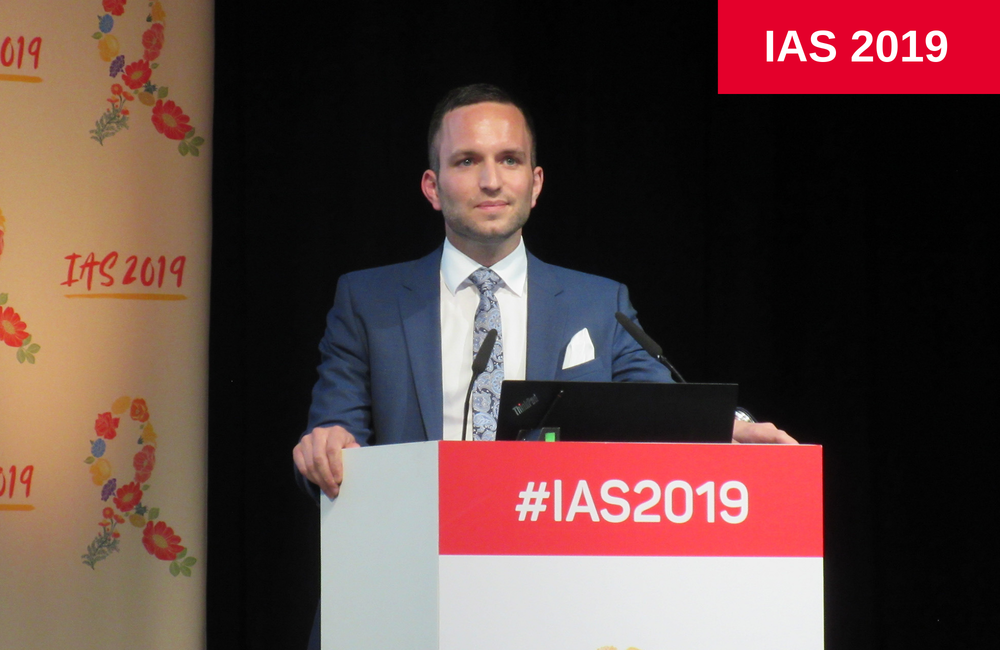
It’s possible that pre-exposure prophylaxis (PrEP) using tenofovir alafenamide/emtricitabine (F/TAF, brand name Descovy) might have a role in providing a more ‘forgiving’ PrEP regimen for people who have sub-optimal adherence to PrEP, or who take it intermittently, than the standard regimen of tenofovir disoproxil fumarate (F/TDF, known by its brand name Truvada, though increasingly available as a non-branded generic).
At the Tenth International AIDS Society Conference on HIV Science (IAS 2019), Dr Christoph Spinner of the Technical University of Munich presented a post-hoc analysis of the findings of the DISCOVER study, which pitted the two regimens against each other.
The primary result from DISCOVER was announced earlier this year and found that F/TAF was non-inferior to F/TDF in preventing HIV; in other words, statistically speaking the efficacy of the two regimens was similar enough to be regarded as equivalent.
DISCOVER only had to show that F/TDF was no more than 62% better at preventing HIV than F/TAF – a threshold few expected it to fail. So it was no surprise that F/TAF was able to meet the criterion for non-inferiority.
In the event, however, there were fewer HIV infections in people taking F/TAF than F/TDF. There were 22 in all, seven on F/TAF and 15 on F/TDF. This equated to an annual HIV incidence of 0.16% a year for F/TAF and 0.34% a year on F/TDF. This means that the ‘incidence rate ratio’ (IRR) was 0.47 for F/TAF, meaning it appeared to be 53% more effective.
It was later found that five HIV infections appeared to be acute ones. i.e. ones that were already underway when people started PrEP: one on F/TAF and four on F/TDF. This adjusted the IRR to 0.55, meaning that F/TAF appeared to be 45% more effective.
The “appeared to be” is important, however. The 95% confidence interval for the finding was 0.19 to 1.15: this means that the statistical uncertainty of the result is such that, if you re-ran DISCOVER exactly 20 times over, you might expect results, just by chance, ranging from F/TAF being 81% more effective to F/TDF being 15% more effective. If a confidence interval crosses 1.00, it means you cannot say that one drug has demonstrated statistical superiority over another. F/TAF could not be said to be superior to F/TDF.
This did not abolish the impression, however, that it seemed to be more effective, and the DISCOVER researchers did some post-hoc analyses. Spinner told the conference that they found that there were only three chances in 1000 that the appearance of greater effectiveness of F/TAF was a random finding, and that there was a 98% probability that F/TAF was, indeed, more effective.
Assuming this was the case – and it is a tricky assumption – why might F/TAF have greater efficacy?
The researchers examined the data to find if there were any differences between participants who took the two regimens in terms of their sexual behaviour, sexually transmitted infections, or adherence. The answer was that there were none. Adherence according to dried blood spot analysis tailed off slightly over the study, from 4-7% taking the equivalent of fewer than four pills a week at the start of the study to 14-16% at the end, but both arms tailed off equally.
When they looked at the people who acquired HIV, however, they found that they all without exception had low adherence but that while no-one taking F/TAF who acquired HIV was taking the equivalent of more than two pills a week, some of the F/TDF seroconverters were taking two to four pills a week.
If this is a significant difference – and it’s rather a slim one – why might this be the case?
The primary difference between TAF and TDF is that TAF spends almost no time in the blood – a matter of seconds – and immediately goes to where it is needed, inside T-cells. This means that levels of drug sufficient to stop viral replication by 90% (the IC90) are achieved within four hours after one dose of TAF, whereas it takes three daily doses of TDF to achieve the same level. The intracellular level of TAF was over the IC90 in 98% of samples from people on TAF, but only 68% in samples from people on TDF.
TAF also stays in cells longer: its level in cells stays above the IC90 for 16 days after a last dose, but only ten days in people on TDF, meaning that the chances of infection rise faster in people who leave gaps in their TDF adherence than in people with gappy adherence to TAF.
It’s therefore possible, Spinner said, that “The more rapid onset and longer duration of protection may be the most probable explanation for the higher prevention efficacy of F/TAF.”
This presentation received some challenge from the audience, as it was pointed out that post-hoc analyses were not as statistically watertight as pre-planned ones, and that the adherence differences in people who acquired HIV were relatively slight between the two arms. It was also pointed out that this difference might not be enough for F/TAF to be cost-effective in terms of its prevention efficacy when as a branded drug it is set against F/TDF generic formulations that might be 90% cheaper.
Given, however, that treatment studies indicate that TAF may only have superior safety when used alongside drugs boosted by ritonavir or cobicistat, and neither of these are used in PrEP, it would be intriguing if TAF does turn out to have a role in people struggling with adherence, rather than because it causes fewer PrEP-stopping side-effects.
Spinner C et al. DISCOVER study for HIV pre-exposure prophylaxis (PrEP): F/TAF has a more rapid onset and longer sustained duration of HIV protection compared with F/TDF. 10th IAS Conference on HIV Science, Mexico City, abstract TUAC0403LB, 2019.
